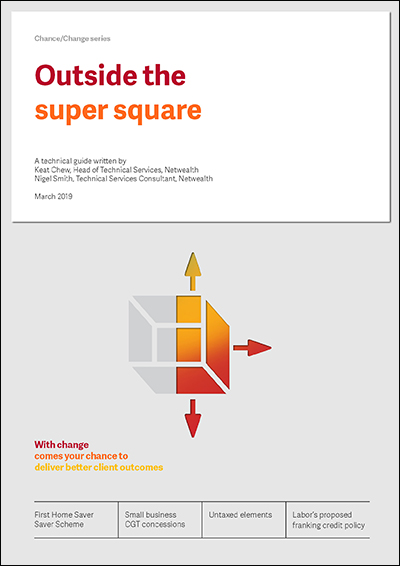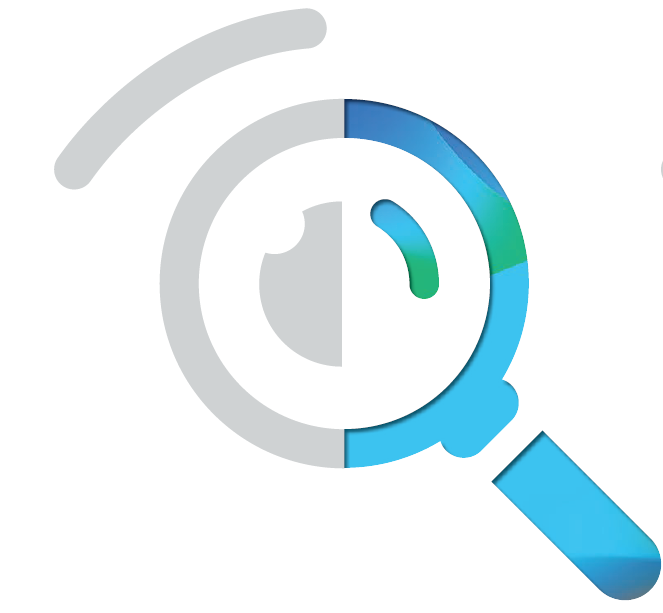The following is an 'adviser-only' summary of information announced in the 2019 Federal Budget that are most likely to be relevant to financial advisers and their advice practice.
Skip to the announcements on:
Superannuation
Taxation
Social security
Small business tax
Superannuation
Relaxed work test for contributions and bring forward provisions
The Government will allow voluntary superannuation contributions, both concessional and non-concessional, to be made by those aged 65 and 66 without meeting the work test from 1 July 2020.
Individuals aged 65 and 66 will also be able to make up to three years of non-concessional contributions under the bring-forward rule.
These two changes are designed to align with the eligibility age for the Age Pension which will be increasing over the coming years to age 67.
Spouse contribution eligibility extended
From 1 July 2020, individuals under the age of 75 will be able to receive spouse contributions, with those aged 65 and 66 no longer required to meet a work test.
Exempt current pension income
From 1 July 2020, the Government will allow superannuation fund trustees with interests in both the accumulation and pension phases during a year of income to choose their preferred method of calculating exempt current pension income (ECPI).
The Government will also remove the redundant requirement for superannuation funds to obtain an actuarial certificate when calculating ECPI using the proportionate method when all of the members of the fund are fully in pension phase.
Defence Force Superannuation Scheme
The Government will extend Australian Defence Force Superannuation Scheme (ADF Super) membership eligibility to allow ADF Super members to choose to remain contributory members when they discharge from the Australian Defence Force.
‘Opt in’ superannuation insurance delayed
The Government will delay to 1 October 2019 the start date for ensuring insurance within superannuation is only offered on an opt-in basis for accounts with balances of less than $6,000 and new accounts belonging to members under the age of 25 years.
Outside the super square
This guide explores four alternative super strategies - First Home Super Saver Scheme, Untaxed elements, Small business CGT super contributions and Labors proposed franking credits - to get you thinking differently about superannuation.
Taxation
Increases in Low and Middle Income Tax Offset
The Government will provide a reduction in tax provided through the use of the non-refundable low and middle income tax offset (LMITO).
Under the changes, the reduction in tax provided by LMITO will increase from a maximum amount of $530 to $1,080 per annum and the base amount will increase from $200 to $255 per annum for the 2018-19, 2019-20, 2020-21 and the 2021-22 income years.
The LMITO will provide a reduction in tax of up to $255 for taxpayers with a taxable income of $37,000 or less. Between taxable incomes of $37,000 and $48,000, the value of the offset will increase at a rate of 7.5 cents per dollar to the maximum offset of $1,080.
Taxpayers with taxable incomes between $48,000 and $90,000 will be eligible for the maximum offset of $1,080.
From taxable incomes of $90,000 to $126,000 the offset will phase out at a rate of 3 cents per dollar.
The LMITO will be received on assessment after individuals lodge their tax returns for the 2018-19, 2019-20, 2020-21 and 2021-22 income years. This will ensure that eligible taxpayers receive a benefit when they lodge returns from 1 July 2019.
Increases in low marginal tax rate thresholds and low income tax offset
From 1 July 2022, the Government will increase the top threshold of the 19% personal income tax bracket from $41,000 to $45,000.
From 1 July 2022, the Government will increase the low income tax offset (LITO) from $645 to $700.
The increased LITO will now reduce at a rate of 5 cents per dollar between taxable incomes of $37,500 and $45,000. LITO will then be reduced at a rate of 1.5 cents per dollar between taxable incomes of $45,000 and $66,667.
Together, the increase to the top threshold of the 19% personal income tax bracket and the changes to LITO will lock-in the reduction in tax provided by LMITO when LMITO is removed.
Reduced marginal tax rate
From 1 July 2024, the Government will reduce the 32.5% marginal tax rate to 30% and the 37% tax bracket will be abolished.
This means that by 2024-25 around 94% of Australian taxpayers are projected to face a marginal tax rate of 30% or less.
Overall impact of proposed tax changes
|
|
New Thresholds from |
|
|
Rates |
2018/19 - 2021/22 |
2022/23 - 2023/24 |
|
Nil |
Up to $18,200 |
Up to $18,200 |
|
19% |
$18,201 - $37,000 |
$18,201 - $45,000 |
|
32.5% |
$37,001 - $90,000 |
$45,001 - $120,000 |
|
37% |
$90,001 - $180,000 |
$120,001 - $180,000 |
|
45% |
Above $180,000 |
Above $180,000 |
|
LMITO |
Up to $1,080 |
- |
|
LITO |
Up to $445 |
Up to $700 |
|
Rates |
New Thresholds from 2024/25 |
|
Nil |
Up to $18,200 |
|
19% |
$18,201 - $45,000 |
|
30% |
$45,001 - $200,000 |
|
45% |
Above $200,000 |
|
LITO |
Up to $700 |
Increasing the Medicare levy low-income thresholds
The Government will increase the Medicare levy low-income thresholds for singles, families, and seniors and pensioners from the 2018-19 income year:
- The threshold for singles will be increased from $21,980 to $22,398.
- The family threshold will be increased from $37,089 to $37,794.
- For single seniors and pensioners, the threshold will be increased from $34,758 to $35,418.
- The family threshold for seniors and pensioners will be increased from $48,385 to $49,304.
For each dependent child or student, the family income thresholds increase by a further $3,471, instead of the previous amount of $3,406.
Social security
Energy Assistance Payment
The Government will provide a one-off Energy Assistance Payment of $75 for singles and $62.50 for each member of a couple who is eligible for qualifying payments on 2 April 2019 and is resident in Australia.
Payments which will qualify for this benefit are the:
- Age Pension
- Carer Payment
- Disability Support Pension
- Parenting Payment Single
- Veterans’ Service Pension and the Veterans’ Income Support Supplement
- Veterans’ disability payments
- War Widow(er)s Pension, and
- Permanent impairment payments under the Military Rehabilitation and Compensation Act 2004 (including dependent partners) and the Safety, Rehabilitation and Compensation Act 1988.
Small business tax
Increasing and expanding access to the instant asset write-off
From 7.30 pm on 2nd April 2019, the Government is increasing the instant asset write-off threshold from $25,000 to $30,000. The threshold applies on a per asset basis, so eligible businesses can instantly write off multiple assets.
Medium-sized businesses will now also have access to the instant asset write-off.
The increased and expanded instant asset write-off will apply from Budget night until 30 June 2020.
Small businesses with aggregated annual turnover of less than $10 million and medium-sized businesses with aggregated annual turnover of $10 million or more but less than $50 million will be able to immediately deduct purchases of eligible assets costing less than $30,000 that are first used, or installed ready for use, from Budget night 2019 to 30 June 2020.
Medium-sized businesses must also acquire these assets after Budget night to be eligible as they have previously not had access to the instant asset write-off.
Eligible small businesses can already immediately deduct purchases of eligible assets costing less than $20,000 that are first used or installed ready for use by 30 June 2019.
On 29 January 2019, the Government announced that it would increase the instant asset write-off threshold for small businesses from $20,000 to $25,000 and extend the instant asset write-off for an additional 12 months to 30 June 2020.
The table below summarises the interactions between the various changes and how they apply.
|
Asset first used or installed |
Small business |
Medium-sized business |
|
1 July 2018 to 28 January 2019 |
< $20,000 |
n/a |
|
29 January 2019 to 2 April 2019 |
< $25,000 |
n/a |
|
3 April 2019 to 30 June 2020 |
< $30,000 |
< $30,000 |
Please note that many of these announcements are yet to be legislated, and things may change before legislation is passed (if it is passed at all). Care should be taken before implementing a financial strategy based on Budget announcements alone.
Disclaimer
Adviser use only – not for further distribution
The material in this presentation has been prepared and issued by Netwealth Investments Limited (Netwealth), (ABN 85 090 569 109, AFSL 230975, RSE L0000192), based on Commonwealth of Australia data. It contains factual information and, if it contains financial advice, it is general financial product advice only and has been prepared without taking into account your individual objectives, financial situation or needs. The information provided is not intended to be a substitute for professional financial product advice and you should determine its appropriateness having regard to your particular circumstances and seek any independent financial or other professional advice you may require. The relevant disclosure document should be obtained from Netwealth and considered before deciding whether to acquire, dispose of, or to continue to hold, an investment in any Netwealth product.
Information in this presentation may contain forward looking statements regarding our views with respect to potential regulatory changes.
While all care has been taken in the preparation of this document (using sources believed to be reliable and accurate), no person, including Netwealth, or any other member of the Netwealth group of companies, accepts responsibility for any loss suffered by any person arising from reliance on this information.
Unless specified otherwise, all information in this presentation is prepared as at 03/04/2019.
With change comes your chance to explore new perspectives
Explore our Change / Chance Series, a collection of guides and resources designed to help you navigate the changing financial advice landscape.


